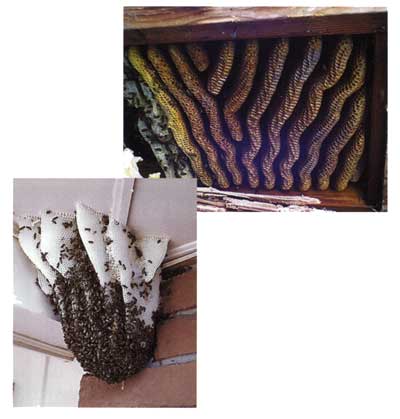By Molly S. Wales

|
This is part of the cover design for Reed Booth’s book about his experiences with Africanized bees. |
You know you’re going to like a guy when, asked how he got started in the honey business, he answers, “I started keeping bees because I drink.”
Reed Booth, otherwise known as the “Killer Bee Guy,” is a home-brewer and mead (honey wine) maker. Fifteen years ago, after settling in Arizona, Booth was joking with his friend that he ought to have some bees on hand for the mead—and shortly thereafter, the friend, who just happened to be a bee inspector, called up to say that she had a bag of the bugs for him. And so, to Booth’s surprise, it began.
Today, Booth is a bee keeper and bee removal expert, plus he has a line of award-winning mustards and butters, all made from his hives’ honey. And, as if bee keeping weren’t intriguing enough already, the bees Booth works with are Africanized, otherwise known as “killer bees.” According to Booth, the Africanized bees moved into Arizona in 1993, and today all of the wild honeybees in the state are killer bees, with a whopping total of 4 to 4 million hives.
 |
These bees tend to be more ornery than your average buzzer. Because of this, Booth in his capacity of killer bee removal expert, gets 3 to 5 calls per day in the summer season. A recent study found that the average number of killer bee removals per year in the city of Tucson alone is 10,000. That’s a lot of bees, and a lot of stings. “I’ve removed bees from anything you can think of that people keep in their back yard,” said Booth. “TVs, cars, you name it. And, because they’re so ornery, when I remove them it feels like hail bouncing off my suit, and it smells like venom.” But, though it is a dangerous job, there are many benefits to working with killer bees. For example, they make twice as much honey a an average European bee. And, when the bees can be saved, Booth gets to take them home. Right now he has 40 hives. And what does he do with all that honey? “I cook,” Booth said. Ten years ago he made dinner for friends with what turned out to be his first official product: Radical Raspberry Honey Butter. He was already selling honey to tourists in his town, so he added the honey butters and honey mustards—and since then, he has won awards ranging from the Arizona Small Business of the Year Award for sales and marketing, to multiple medals at the most recent Napa Valley World Mustard Competition. |
The honey butters and mustards come in a very wide variety of flavors, including the Stinger Smooth Honey Mustards which, said Booth, “have a wasabi effect.” The recent gold medal winner at the 2005 NVWMC was Booth’s Whole Seed Roasted Garlic Honey Mustard. He also sells pollen, lip balm, a book about his experiences with killer bees, and other bee-related products.
At the 2005 Fiery Foods Show, the buzz going around was that Booth’s honey products promoted a euphoric feeling—just the right kind of sting. Maybe that’s because, as Booth explained in conclusion, “Honey is so good for you, it’s ridiculous. You could actually live on it. It’s a miracle food.” Visit Reed Booth’s website, here. Reed’s Honey Mustards are available in Europe exclusively at the Pepperworld Hot Shop. Also, for those who understand German, or just would enjoy seeing more KBG pics, the article is here.
Booth removes Africanized bee hives that have been constructed in areas that prove inconvenient for nearby human activity. |
 |




